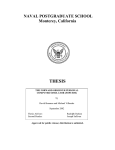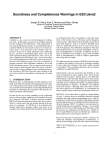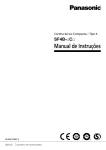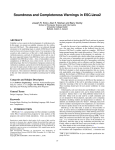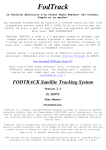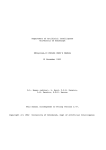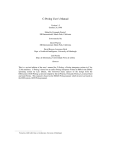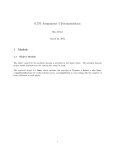Download Introduction to Prolog - Course notes are available at York only
Transcript
Department of Computer Science
Logic Programming and AI
Introduction to Prolog
Department of Computer Science
Prolog Labs
• Lab assignment: see LPA web page.
• No hand-in of lab problem solutions.
• “Official” solutions will be posted on the
web.
Department of Computer Science
Prolog Interpreter
• We will be using SWI Prolog, a freeware
interpreter: http://www.swi-prolog.org
• There is a commercial Prolog interpreter
on the computer science servers:
Sicstus Prolog.
Department of Computer Science
Prolog books
• Bratko: Prolog Programming for Artificial
Intelligence (3rd edition)
• Sterling & Shapiro: The Art of Prolog
(2nd edition).
• Rob Lucas: Mastering Prolog
• Clocksim & Mellish: Programming in
Prolog: Using the ISO standard (5th
edition)
Department of Computer Science
Free Prolog Books
• Nilsson & Maluszynski: Logic,
Programming, and Prolog
(http://www.ida.liu.se/~ulfni/lpp)
• Blackburn, Bos & Striegnitz: Learn
Prolog Now
(http://www.coli.uni-sb.de/~kris/learn-prolognow/)
Department of Computer Science
Logic Programming
• Declarative programming paradigm:
emphasis on what the program does,
not how it goes about doing it.
• Use the language of logic to specify a
problem, and then use a proof
procedure to do the computation.
• Prolog: use SLD-resolution proof
procedure.
Department of Computer Science
Logic Programming System
• A Logic Programming System should be
such that if a solution to our problem
exists, then a proof should exist given
the problem specification.
• Program: logical specification of a
problem.
• Computation: proof (i.e. running the
program).
Department of Computer Science
Advantages
•
•
•
•
•
Very high level language
Easy to prototype
Shorter programs
More readable programs
Ideal for many AI applications
Department of Computer Science
Disadvantages
• Not intuitive to procedural programmers.
• Steep learning curve initially.
• Program execution comparatively slow:
often prototyping in Prolog, and then
optimized implementation in C/C++
Department of Computer Science
Prolog without Variables
Consider the following program:
ed_lives_in_york.
ed_is_a_cs_student.
ed_does_lpa.
Once we load this program into Prolog, we can type
in the following query:
?- ed_lives_in_york.
and Prolog will respond with: Yes
Department of Computer Science
Conjunction
We could ask the following query from Prolog: is it the
case that Ed lives in York and that he does LPA?
This is how:
-? ed_lives_in_york, ed_does_lpa.
The obvious reply from Prolog given our previous
program is:
Yes
Department of Computer Science
Adding Simple Rules
Consider this program:
ed_lives_in_york.
ed_is_a_cs_student.
ed_does_lpa.
ed_loves_logic :- ed_is_a_cs_student,
ed_does_lpa.
The rule above is equivalent in logic to
• ed_loves_logic ed_is_a_cs_student ed_does_lpa.
• ed_is_a_cs_student ed_does_lpa ed_loves_logic.
Department of Computer Science
The Logic Perspective
Ed’s program in logic
1. ed_lives_in_york
2. ed_is_a_cs_student
3. ed_does_lpa
4. ed_is_a_cs_student ed_does_lpa ed_loves_logic
Can we deduce ed_loves_logic from the premises above?
What response can we expect for the query:
-? ed_loves_logic.
Department of Computer Science
Another Example (1a)
p.
s.
q :- p, r.
r :- s, p.
Can we deduce q from this program?
Department of Computer Science
Another Example (1b)
How does Prolog go about deducing q? SLD!
1. to prove q, we must prove both p and r
2. p is true (given)
3. to prove r, we must prove both s and p
4. both s and p are true (given)
5. done!
This way, by working through the implications, Prolog
only has to prove things that are relevant in proving
the goal.
Department of Computer Science
Another Example (2a)
1. P
2. S
3. P R Q
4. S P R
Q
Is this a valid argument of propositional logic?
Department of Computer Science
Another Example (2b)
Q
(3)
PR
(1)
R
(4)
SP
(2)
P
(1)
Department of Computer Science
Prolog Body Parts
• Informally, the thing before the :- is the
head and the thing after the :- is the
body.
• In Prolog, we can only have a head with
one predicate, whereas the body can be
a conjunction or disjunction of predicates.
• Things that end in a full-stop are known
as clauses.
Department of Computer Science
Disjunction
Disjunction exists in Prolog as the semicolon “;” but
it is good practice to avoid using it.
In fact, we can always get rid of disjunctions from the
body of a clause as follows:
p :- q ; (r,s).
is the same as :
p :- q.
p :- r,s.
Department of Computer Science
Beyond Propositional
• So far, we have only considered ground
clauses and queries.
• Restriction to propositional logic makes
it infeasible to handle bigger databases.
• The real power of Prolog is only
revealed with the use of variables.
Department of Computer Science
The parent database (1)
tom
harry
john
mary
helen
george
ed
Well, it could have happened in ancient Greece ….
Department of Computer Science
Parent Program
parent(tom, harry).
parent(tom, mary).
parent(harry, john).
parent(harry, helen).
parent(mary, helen).
parent(mary, george).
parent(helen, ed).
parent(george, ed).
Department of Computer Science
Queries (1)
How can we find out who is the parent of whom?
For example, what query would we give to Prolog to
find the parents of Ed?
?- parent(X, ed).
Prolog would respond with:
?- X = helen
and it would sit there and wait. . .
Department of Computer Science
Queries (2)
If we press the semicolon (which means give me
another answer ), Prolog would respond with:
?- parent(X, ed).
X = helen ;
X = george
and if we tried the semicolon again, we’d get:
No
Department of Computer Science
Queries (3)
What if we wanted to know every parent-child pair?
?- parent(X,Y).
X = tom
Y = harry ;
X = tom
Y = mary ;
X = harry
Y = john ;
and so on until pressing the semicolon would return No
Department of Computer Science
Prolog and Resolution
The query
?- parent(X, ed).
is equivalent to X: parent(X, ed) in the FOPC.
Can we have more complex queries?
Sure, for example, the following will return Ed’s
grandparents:
?- parent(X, ed), parent(Y,X).
How about a great grandfather?
Department of Computer Science
The grandparent Relation
Add the following rule to the database:
grandparent(X,Y) :- parent(X,Z), parent(Z,Y).
The same in logic:
X Y Z (grandparent(X,Y) parent(X,Z) parent(Z,Y))
The same in English: If some individual X is the
parent of Z and Z is the parent of some other
individual Y, then X is the grandparent of Y.
Department of Computer Science
A New Program
parent(tom, harry).
parent(tom, mary).
parent(harry, john).
parent(harry, helen).
parent(mary, helen).
parent(mary, george).
parent(helen, ed).
parent(george, ed).
grandparent(X,Y) :- parent(X,Z), parent(Z,Y).
Department of Computer Science
Queries on Grandparents
A query to find Ed’s grandparents:
?- grandparent(X,ed).
will return Harry and Mary.
A query to find Tom’s grandchildren:
?- grandparent(tom,X).
will return John, Helen and George.
Department of Computer Science
Prolog vs. C (1)
A bunch of queries:
1. given a person, compute his/her grandchildren
2. given a person, compute his/her grandparents
3. given two people, compute whether the former is
the grandparent of the latter
4. compute all grandparent/grandchildren pairs
Department of Computer Science
Prolog vs. C (2)
The same relation, that of parenthood, is involved in
all cases. In Prolog, we can get away by just defining
just one relation:
grandparent(X,Y) :- parent(X,Z),
parent(Z,Y).
We then vary the query. The variables X and Y in
grandparent may be:
instantiated mapped to constants
uninstantiated mapped to variables
Department of Computer Science
A Smaller Parents Database
tom
mary
steve
harry
helen
emma
ed
Department of Computer Science
The Parent Database in
Prolog
parent(tom, harry).
parent(mary, harry).
parent(steve, emma).
parent(helen, emma).
parent(harry, ed).
parent(emma, ed).
Department of Computer Science
Polymodality
Polymodality is the ability to have multiple modes in
our programs or queries i.e. multiple patterns of
instantiation:
?- parent(tom, harry).
?- parent(mary, X).
?- parent(X, mary).
?- parent(X,Y).
Department of Computer Science
Cleaner Output
We want to find Tom’s children who have children of
their own:
?- parent(tom, X), parent(X,Y).
X = harry
Y = ed ;
No
But, we’re just interested in the value of X, not Y , as
long as some Y exists.
Department of Computer Science
Anonymous Variables
We can use anonymous variables:
?- parent(tom, X), parent(X,_).
X = harry ;
No
Department of Computer Science
Anonymity Pitfalls
The query:
?- parent(tom, _), parent(_,_).
is not the same as
?- parent(tom, X), parent(X,_).
but is, in fact, equivalent to:
?- parent(tom, X), parent(Y,Z).
Department of Computer Science
Listing
To get a listing of your Prolog program:
?- listing.
Sometimes, as you change your program, Prolog
“remembers” older definition of the predicates in
your code. In these cases, it is a good idea to exit the
interpreter and restart it to clear the memory.
Department of Computer Science
Trace
[trace] ?- parent(tom, X), parent(X,Y).
Call: (8) parent(tom, _G284) ? creep
Exit: (8) parent(tom, harry) ? creep
Call: (8) parent(harry, _G287) ? creep
Exit: (8) parent(harry, ed) ? creep
X = harry
Y = ed ;
Fail: (8) parent(harry, _G287) ? creep
Fail: (8) parent(tom, _G284) ? creep
No
Department of Computer Science
Ancestors
• Question: Who are my ancestors?
• My ancestors are my parents, my parent’s
parents, my parents’ parents’ parents, my
parents’ parents’ parent’s parents etc. . .
• My ancestors are either my parents or the
ancestors of my parents.
• What is the definition of the ancestor
relation in Prolog?
Department of Computer Science
Ancestors in Prolog
parent(tom, harry).
parent(mary, harry).
parent(steve, emma).
parent(helen, emma).
parent(harry, ed).
parent(emma, ed).
ancestor(X,Y) :- parent(X,Y).
ancestor(X,Y) :- parent(X,Z), ancestor(Z,Y).
Department of Computer Science
Queries and Search Trees
What is the search tree associated with the query:
ancestor(X,ed)?
1. Translate the Prolog program back into the
FOPC
2. Translate the query to a conclusion for the
argument whose premises are the sentences
from the Prolog program
3. Do the SLD-resolution proof for the resulting
argument!
Department of Computer Science
From Prolog to Logic
1. Parent(tom, harry)
2. Parent (mary, harry)
3. Parent (steve, emma)
4. Parent (helen, emma)
5. Parent (harry, ed)
6. Parent (emma, ed)
7. Parent (x, y) Ancestor(x, y)
8. Parent (x, z) Ancestor (z, y) Ancestor (x, y)
Ancestor (x, ed)
Department of Computer Science
Partial Search Space
A(x,ed)
P(x,z) A(z,ed)
P(x,ed)
P(tom,harry) P(mary,harry)
A(harry,ed) A(harry,ed)
P(steve,emma)
A(emma,ed)
P(helen,emma) P(harry,ed)
A(emma,ed) A(ed,ed)
A(emma,ed)
P(emma,ed)
P(emma,z1) A(z1,ed)
P(tom,harry)
A(harry,ed)
Department of Computer Science
Prolog’s Search Strategy
• Branches in the previous tree represent
alternative solutions.
• Prolog searches the tree in a depth-first
manner.
• Solutions are found by the Prolog interpreter
in the same order as they are discovered by
DFS.
• The order of the clauses in the Prolog
program is important.
Department of Computer Science
A Different Program
parent(tom, harry).
parent(mary, harry).
parent(steve, emma).
parent(helen, emma).
parent(harry, ed).
parent(emma, ed).
ancestor(X,Y) :- parent(X,Z), ancestor(Z,Y).
ancestor(X,Y) :- parent(X,Y).
Department of Computer Science
What’s the difference?
• What is the search tree associated with
the same query as before:
ancestor(X,ed)?
• Is the search space different?
• Are the same solutions found?
Department of Computer Science
Another Pitfall
Consider the following program:
likes(ed,emma).
likes(ed,john).
likes(ed,X) :- likes(X,ed).
Department of Computer Science
Another Pitfall (2)
What is the search space associated with the query:
likes(ed,X).
?- likes(ed,X).
X = emma ;
X = john ;
What happens next?
Department of Computer Science
Another Pitfall (3)
Prolog went into an infinite loop trying to prove
the goal: likes(ed,ed).
Department of Computer Science
Infinite Loops
• We can expect infinite computation
when using infinite relations (or mutually
recursive ones).
• But, the way Prolog does things means
that even some finite queries can fail!
• Prolog’s strategy:
– Try clauses from top to bottom.
– Try subgoals from left to right.
Department of Computer Science
Logic vs. Prolog
Four logically equivalent programs:
a(X,Y) :- p(X,Y).
a(X,Y) :- p(X,Z), a(Z,Y).
a(X,Y) :- p(X,Z), a(Z,Y).
a(X,Y) :- p(X,Y).
a(X,Y) :- p(X,Y).
a(X,Y) :- a(Z,Y), p(X,Z).
a(X,Y) :- a(Z,Y), p(X,Z).
a(X,Y) :- p(X,Y).
Department of Computer Science
Rules of Thumb
• Do not have recursive calls as the first
subgoal (so-called left recursion).
• Put the base case as the first clause.
• Be prepared to break these rules.
Department of Computer Science
Data Structures
• Prolog supports only the term data structure:
A term in Prolog is a constant or a variable
or a function symbol of arity n applied to n
terms.
• Sometimes, the words function symbol and
functor are used interchangeably.
• Variables can have numerical or list values
(see later lectures).
Department of Computer Science
LPA staff database
Consider the following database:
person(name(matthew, grounds),
sex(male)).
person(name(alan, frisch),
sex(male)).
person(name(daniel, kudenko),
sex(male)).
Is any one of them called matthew?
?- person(name(matthew, _), sex(_)).
Yes
Department of Computer Science
An Alternative
person(firstname(matthew),
surname(grounds),
sex(male)).
person(firstname(alan),
surname(frisch),
sex(male)).
person(firstname(daniel),
surname(kudenko),
sex(male)).
Department of Computer Science
Lists
A list is an ordered set of elements. In Prolog, lists
are used very extensively so it’s good to
understand them early.
In Prolog:
• a list is either empty []
• or it is made up of a head H and a tail (body) T
as follows: [H|T]
Department of Computer Science
Examples of Lists
[1,2,3,4,5] is a list with head 1 and tail
[2,3,4,5].
[likes(ed,guiness), likes(ed,ghost)] is a
list with head likes(ed,guiness) and tail
[likes(ed,ghost)]
Department of Computer Science
Syntax of Lists
list
[ ] |
.(head,tail)
head term
tail
list
Note that in the definition above, .(head,tail) is
Prolog’s way of writing [head | tail]
Department of Computer Science
More Syntactic Sugar
The list: [X1, X2, X3 | X4] is a list:
1. First element is X1
2. Second element is X2
3. Third element is X3
4. Remainder is the list X4
Note that the list above is different to:
[X1, X2, X3, X4]
Department of Computer Science
List Notation
Commas “,” separate individual list elements. The bar
“|” separates an element and the rest of the list.
1. [] contains zero elements
2. [Y|Ys] contains at least one element
3. [Y1,Y2|Ys] contains at least two elements
4. [Y1|Y2,Y3] is a syntax error
5. [Y1 | [Y2,Y3]] is the same as [Y1,Y2,Y3]
6. [Y1 | [Y2 | Y3]] is the same as
[Y1,Y2 | Y3]
Department of Computer Science
Pure Prolog Syntax (1)
Program Clause. |
Clause. Program
Clause
Fact |
HornClause
Fact
Literal
Literal
p |
p(t1, t2, … , tn)
where p is a predicate symbol and t1, t2, … , tn are
terms.
Department of Computer Science
Pure Prolog Syntax (2)
HornClause
Head :- Body
Head Literal
Body Literal |
Literal, Body |
Literal; Body
Department of Computer Science
A First “Real” Program
• Write a program that can evaluate Boolean
expressions.
• What do we need to write such a program?
– Decide which Boolean functions to include (‘and’,
‘or’, ‘not’, etc).
– How do we define the Boolean functions in
Prolog?
– Choose a value for True and one for False.
– Back to truth tables!
Department of Computer Science
Boolean Expressions
• Represent the ‘and’, ‘or’ and ‘not’ Boolean
functions.
• Represent TRUE by the constant true.
• Represent FALSE by the constant false.
• Note that a truth table is simply a relation.
• Represent the basic truth tables with ground
rules.
• Implement the evaluation mechanism through
Prolog rules.
Department of Computer Science
Truth Tables
P
P
P Q
PQ
T
F
T
T
T
T
T
T
F
T
T
F
F
T
F
T
F
T
F
F
T
T
F
F
F
F
F
F
P Q
PQ
Department of Computer Science
Ground Clauses
eval(and(true, true), true).
eval(and(false, true), false).
eval(and(true, false), false).
eval(and(false, false), false).
eval(or(true, true), true).
eval(or(true, false), true).
eval(or(false, true), true).
eval(or(false, false), false).
eval(not(true), false).
eval(not(false), true).
Department of Computer Science
Boolean Evaluation (1)
First, we need some way to encapsulate the Boolean
functions so that Prolog can match them:
eval(v(true), true).
eval(v(false), false).
Finally, we are ready to ask ourselves: What does it
mean for P Q, P Q, P to be true?
Department of Computer Science
Boolean Evaluation (2)
eval(and(A, B), V):eval(A, AV),
eval(B, BV),
eval(and(AV, BV), V).
eval(or(A, B), V):eval(A, AV),
eval(B, BV),
eval(or(AV, BV), V).
eval(not(A), V):eval(A, AV),
eval(not(AV), V).
Department of Computer Science
Demonstration (1)
Forward reasoning: what is the truth value of the
expression TRUE FALSE?
?- eval(and(v(true), v(false)), X).
X = false ;
No
Department of Computer Science
Demonstration (2)
Backward reasoning: what truth values for X and Y
make the expression (X Y ) (Y X) true?
?- eval(and(or(v(X), v(Y)),
and(v(Y), v(X))
), true).
X = true
Y = true ;
No
Department of Computer Science
Unification (1)
Prolog uses resolution as its only rule of inference!
The unification operator is ‘=’
Examples:
?- i_love_beer(ed,said) = i_love_beer(X,said).
X = ed
?- hello(you, f(Y)) = hello(X, f(fool)).
X = you
Y = fool
Department of Computer Science
Unification (2)
Sometimes, unification can also fail:
?- p(X,f(X)) = p(f(X), X).
X = f(f(f(f(f(f(f(f(f(f(...))))))))))
?- p(X) = p(f(X)).
X = f(f(f(f(f(f(f(f(f(f(...))))))))))
Department of Computer Science
Operators in Prolog
Say we want to write that 4 is less than 5 in Prolog.
How can we do it?
As it turns out, Prolog does have these operators
built-in:
?- <(4,5).
?- 4 < 5.
Yes
Yes
?- >(4,5).
?- 4 > 5.
No
No
Department of Computer Science
Infix and Prefix
• The operator/functor “<“ in X < Y is an
infix operator.
• X < Y is internally translated to the term
< (X, Y )
• The operator/functor “<“ in < (X, Y ) is a
prefix operator.
Department of Computer Science
Mixedfix
• Another Prolog builtin operator is
[ _ | _ ]. This is a mixedfix operator
which also takes two arguments. This
operator is also translated to .(X,Y)
internally.
• Note that “.” is a functor symbol in this
context and not a clause terminator.
Department of Computer Science
User-defined Operators
• Prolog also allows you to define your
own operators (op/3). For example,
instead of writing: and(v(1),v(0))
we can write: v(1) & v(0) provided
we define “&” as a new infix operator.
• Often, there’s no need to define
operators. Check the user manual for
more details.
Department of Computer Science
Procedural vs. Declarative
Semantics (1)
The prolog program:
p :- q,r.
is “supposed” to mean the same as:
p :- r,q.
But, in practice, they are different.
Department of Computer Science
Procedural vs. Declarative
Semantics (2)
In the program:
p :- q,r.
how does Prolog solve the query:
?- p.
1. first solve q
2. then solve r
Department of Computer Science
Procedural vs. Declarative
Semantics (3)
• Unfortunately, we must sometimes take
Prolog’s way of solving queries into
account:
– to avoid infinite search
– for efficiency
– to hack certain tricks
Department of Computer Science
Prolog Tips and Tricks (1)
• Spell the predicates correctly.
• Pass the right number of arguments to each
function.
• Locate operators and determine their
precedence.
• Introduce brackets to avoid confusion.
• Determine the pattern of instantiation of
variables and make sure it matches the
intended use by the rest of the program.
Department of Computer Science
Prolog Tips and Tricks (2)
• It is good practice to:
– put all ground clauses of a predicate at the top of
the Prolog file.
– put all other clauses that define a predicate
together below the ground ones
• Common errors:
– Forgetting the full stop at the end of a clause
– Having unmatched round brackets ( ), square
Brackets [ ] or curly brackets (braces) { }
Department of Computer Science
Trace
A very useful tool that comes with Prolog is the
trace command. It has the following events:
1. Call: Prolog starts trying to solve a goal.
2. Exit: Some goal has been solved by Prolog.
3. Redo: Prolog begins to re-solve a goal.
4. Fail: Prolog has failed to solve a goal.
Department of Computer Science
Trace: Spy Points
• To trace only a specific predicate pred of
your program, set a spy point: spy(pred).
• To remove the spypoint for a predicate pred:
nospy(pred).
• If more than one version of pred exists (e.g.,
one of arity 2 and one of arity 3), we can spy
on them individually or together. Example:
spy(pred/2).
Department of Computer Science
Trace: Leashing
• Another useful feature is leashing which
controls which parts of a trace the user is
shown.
• leash(+call) tells Prolog that we are
interested in the call event.
• leash(-fail) tells Prolog that we are not
interested in the fail event.
• leash([+call,+exit,-redo,-fail]).
tells Prolog that we are interested in calls and
exits but not in redos and failures.
Department of Computer Science
Trace Commands (1)
• creep (the “Return” key) tells Prolog to
carry on until the next leashed event.
• skip (the “s” key) tells Prolog to carry
on and produce no trace messages until
another event occurs involving the
current goal.
• leap (the “l” key) tells Prolog to carry
on and produce no trace messages until
either a spy point is reached or another
event occurs involving the current goal.
Department of Computer Science
Trace Commands (2)
• break (the “b” key) tells Prolog to exit the
current trace. It gives us a temporary new
interpreter (shell) and we can resume our
trace with “Ctrl D”.
• abort (the “a” key) tells Prolog to abandon
the current trace altogether.
• exit (the “c” key) tells Prolog to exit the
current trace and terminate the Prolog
interpreter thus returning us to the shell.
Department of Computer Science
SWI Manual
• As with all programming languages, the most
important aid in learning to develop good
programs with Prolog is the language
manual.
• Get it at: http://www.swi-prolog.org
• The Prolog interpreter also has the help/0
and help/1 predicates for you to use which
access the manual.
Department of Computer Science
Back to Lists
Consider the following list-membership program:
memb(X,[X|_]).
memb(X,[_|T]) :- memb(X,T).
Note that memb is not a fully polymodal predicate as
we can’t ask Prolog the queries:
?- memb(1, X).
?- memb(X,Y).
Department of Computer Science
Types (1)
Prolog is not a typed language, e.g. the following
queries perhaps should give type errors, but they
don’t:
?- memb(a, [a|b]).
Yes
?- memb(b, [a|b]).
No
How does Prolog come to the above two conclusions?
Department of Computer Science
Types (2)
Suppose we define a predicate list/1, where
list(X) would be true if X is a list:
list([]).
list([X|Xs]) :- list(Xs).
How could we then make the memb/2 predicate
more type safe?
Department of Computer Science
Types (3)
Then, we could make memb type safe(r):
memb(X, [X | Xs]) :- list(Xs).
memb(X, [Y | Ys]) :- memb(X, Ys).
Now, the previous queries behave as expected:
?- memb(a, [a | b]).
No
?- memb(b, [a | b]).
No
Department of Computer Science
Appending Two Lists (1)
We’d like to define the predicate append/3 where
append(Xs, Ys, Zs) is true if Zs is the list
formed by concatenating Ys to the end of Xs.
For example:
?- append([a, b, c], [d, e], L).
L = [a, b, c, d, e]
Department of Computer Science
Appending Two Lists (2)
The base case of append/3 concerns the case
where Xs is the empty list:
append([], Ys, Ys).
In English: if you try to append the empty list to
another list, simply return the other list.
Department of Computer Science
Appending Two Lists (3)
If the first argument of append/3 is a non-empty list
(i.e. one that has at least one element):
append([X|Xs], Ys, [X|Zs]) :append(Xs, Ys, Zs).
In English: if you try to append a list with at least one
element in it to a second list, return a new list whose
head is the head of the first list and whose tail is the
second list glued on to the tail of the first list.
Department of Computer Science
Appending Two Lists (4)
• We recurse on only one argument, as is
often the case.
• append is left-recursive.
• append describes an infinite relation.
• append is also not fully polymodal.
• But: some of the modes that append
offers are very useful indeed.
Department of Computer Science
Reversing a List
An example of the usefulness of append is
reversing a list:
reverse([], []).
reverse([X | Xs], Ys) :reverse(Xs, Zs),
append(Zs, [X], Ys).
You’ll get lots more practice in the practicals!

































































































